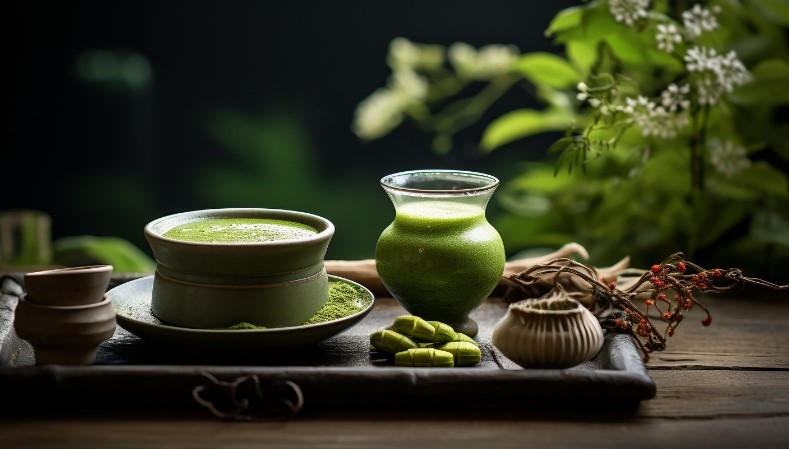El camino del matcha

La relación entre matcha and Japan, like watches to Switzerland, perfume to France, although not “tight”, but always closely linked.
Today’s Japanese matcha has long become the most important symbol and carrier of Japanese tea drinking culture, and is loved and recognized by more and more consumers.
Pass on
In popular terms, matcha is a powdered tea product formed from tea leaves after special processing. This is also the reason why matcha was written as “last tea” in the Chinese script in the early years, where “last” means “powder” and “broken powder”.
The rise of tea drinking in Japan has not been without its difficulties.
According to Japanese historical records, as early as the Nara era, the Japanese monk Yuki brought Chinese tea trees back to Japan. But growing tea didn’t really catch on at that time.
In the Nara and Heian periods, Japanese tea culture had not yet developed its own characteristics, but was only a preliminary study and copy of Chinese tea culture. Among the nobles, monks and upper classes of the Riwiting Dynasty, tea planting, tea making, tea drinking, each step is similar to the Tang Dynasty, and the taste of imitation is very strong.
During the Kamakura period, Japanese tea culture began to integrate with local religion, philosophy, aesthetics, etc., forming a Japanese style called “tea soup”. The application of matcha tea has also become an important part of Japanese tea culture.
Interestingly, by the Muromachi era, the style of tea drinking in Japan began to change. At this time, China had entered the Ming Dynasty, but Japan, across the sea, suddenly yearned for the tea art of China’s Song Dynasty, and imitated the wind of “fighting tea” in the Song Dynasty, and formed its own “fighting tea” art.
In the early Muromachi period, luxury “tea fighting” became the mainstream. Unlike the elegant “tea fighting” of the Song Dynasty, the purpose of “tea fighting” of the Japanese samurai class was to expand social contacts, show off wealth, and of course, eat and drink. It may be because such “fighting tea” is really not elegant, luxury “fighting tea” flourished and declined, and the tea culture of Dongshan Academy began to rise.
As a very popular culture in the middle of the Muromachi period, Higashiyama culture has a strong bookish atmosphere. At that time, under the guidance of the Zen master Murata, the academy tea combined the foreign Chinese culture with the Japanese culture, making the “tea soup” more technical, and the Japanese tea ceremony also took shape. Because of this, the Higashiyama period, or Higashiyama culture, occupies a very important position in the history of Japanese tea ceremony.
After the early Nara and Heian eras, the middle Kamakura and Muromachi eras, the late Edo eras and the modern era, Japanese tea culture has finally matured.
Access road
In the process of the localization of tea culture, with the emergence of masters one after another, fine, exquisite and wonderful have become the characteristics of Japanese tea ceremony.
Improve the quality
During the Muromachi era, Uji tea farmers invented the “mulch cultivation method” specifically for the local soil and climate, that is, before the tea is picked, the tea trees are “covered” to make the matcha more green and sweet, and Uji matcha is also famous.
Improve the process
For the Japanese at that time, tea was more like a craft than a drink. Reflected in the tea making process, is more rigorous steps and more sophisticated operations. From shading before picking, steam killing after picking, baking in the oven to cutting and crushing, more than a dozen processes are exquisite, and even the stone mill used in the fine grinding processing link is the pursuit of natural.
Reform tea style
In the tea culture of Dongshan Academy, the artist Neng Ami is an important representative. He was born as a warrior, and he is well versed in writing, painting and tea. Under his auspices, the Japanese tea Party swept away the extravagant and noisy wind, and began to form a new tea style of “academy decoration” and “table decoration”.
Form a tea ceremony
At Noi’s recommendation, Murata became a tea ceremony teacher to shogun Yoshimasa Ashikaga in his later years. After fully understanding the tea culture of Dongshan Academy and coming into contact with a large number of cultural and artistic treasures collected by the general, Murata Pearl’s tea ceremony thought made a further leap. He combined Nara Ryu “Soan tea” from the common class with “Academy tea” from the noble class, completing an important step from tea culture to tea ceremony. Murata Pearl is also known as “the ancestor of the Japanese tea ceremony”.
At this point, the three steps necessary for the formation of tea ceremony – the folk tea, the combination of tea and Zen, and the integration of noble tea and folk tea have all been completed. After years of accepting the Chinese custom of eating tea, the Japanese finally developed their own tea ceremony.
proveedor de matcha: www.backvita.com
Correo electrónico: [email protected]
Teléfono: +86 (029) 8187 2325
